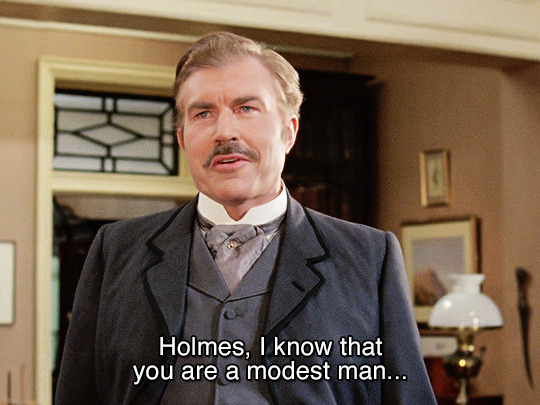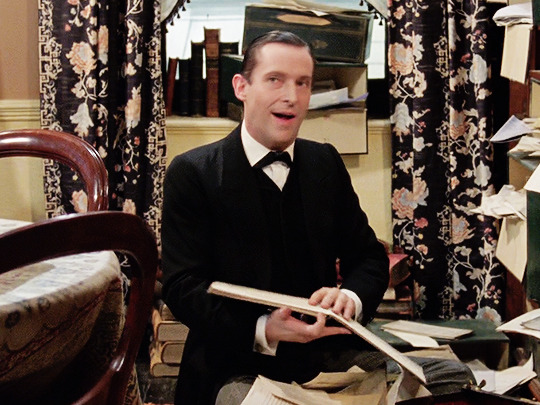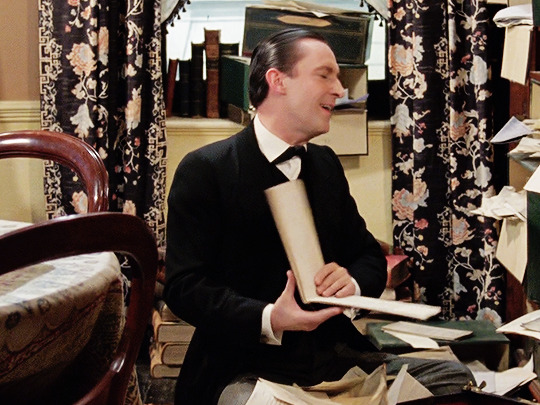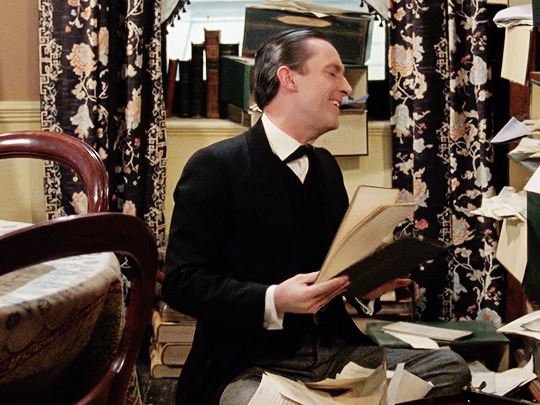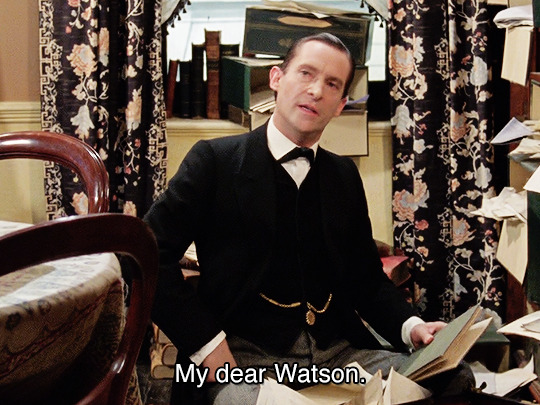mydearsigerson
2K posts
J. 20s, queer, Norway. I post pretty much every adaptation except BBC. H/W tag:otp: it is both or none.
Don't wanna be here? Send us removal request.
Text
been rereading some holmes and here are some things:
holmes has an established habit of wriggling in his chair when happy / excited
when discussing how strange the world is, holmes says to watson “if we could fly out of this window, hand in hand,” and then goes on to talk about how everyone has something bizarre and hidden about them or something but honestly my brain shut off after the bit about flying through the skies of london hand-in-hand with watson
within weeks of moving in together, holmes knows all of watson’s favorite songs to hear on the violin, and frequently plays them just to appease watson after hours of violin noodling for his own pleasure
539 notes
·
View notes
Text
Holmes and Watson: the Bohemian Connection.
This is a post I made for the Facebook group 221B Here, and I’m putting it up here in case any of my Tumblr people are interested. Of course the FB group has plenty of people who are het, and quite anti Holmes and Watson coded as gay, but it will be interesting to see the response.
Someone asked about the word “Bohemian” used of Holmes and Watson. I offer the following initiator for discourse.
A Bohemian Soul.
In the first Sherlock Holmes story he ever penned, Conan Doyle shows us Watson, in STUD, reading that seminal work by Henri Murger “Scènes de la Vie de Bohème” as he waits up for Holmes to return from investigating the murder of Enoch Drebber:
“It was close upon nine when he set out. I had no idea how long he might be, but I sat stolidly puffing at my pipe and skipping over the pages of Henri Murger’s “Vie de Bohème”” (STUD)
The choice of reading matter, as well as other indications in the text, indicate how Conan Doyle intended to position both Holmes and Watson as living unconventional lives outside society: as “Bohemians”.
But what did the Victorians understand by the terms “Bohemianism”, “bohemian” and “a bohemian lifestyle”?They understood the lifestyle to be the opposite of conventional: artistic, musical, liberal, irregular, and the person practising it to be all of those things.
What is a Bohemian? The word “Bohemia” is a toponym. Tacitus, (Germania, 28) says: “Accordingly, the tract betwixt the Hercynian forest and the rivers Rhine and Mayne was possessed by the Helvetii: and that beyond, by the Boii; both Gallic tribes. The name of Boiemum still remains, a memorial of the ancient settlement.” The term was later used in France (from about the C15th) as a pejorative term for Romani people, who were thought (incorrectly) to originate from the kingdom of Bohemia (in Victorian times a subject part of the Austro-Hungarian Empire, since 1918 Czechoslovakia, and now the Czech Republic.)
From about the 1830s, however, the French association of “Bohémian” with Romani: rootless wanderers living outside, and frequently at odds with, conventional society, led to its adoption as a counter-cultural identity by groups of artists, musicians, writers and other creators living in the lower rent districts of Paris, on the Rive Gauche and around Montparnasse. (Montparnasse itself being named after Mount Parnassus, the home of Apollo and the nine Muses.) They defined, and conventional society characterised, their lifestyles as those of “free love”, voluntary or involuntary poverty, anti-establishment politics, and social and sexual liberalism in the service of their creativity. Serving as real life muses to this colony of mostly male creators were “grisettes”, young working girls, dancers, actresses and singers on the edge of society.
The “grisette” became a frequent character in bohemian French fiction. George du Maurier based large parts of Trilby on his experiences as a “bohemian” student in Paris during the 1850s. Poe wrote an 1842 story about a grisette, based on the unsolved murder of Mary Cecilia Rogers near New York City. He subtitled it “A Sequel to ‘The Murders in the Rue Morgue” and it was the first detective story to attempt the solution of a real crime.The most famous grisette is Mimi in Henri Murger’s novel (and subsequent play) “Scènes de la Vie de Bohème”, the source for Puccini’s famous opera La Bohème. Liane de Pougy, one of “les grandes horizontales”, Lillie Langtry and Katharina Schratt were examples of how far a grisette with beauty, wit and intelligence could go - and Conan Doyle’s Irene Adler fits the same mould of a woman existing in bohemian society under her own recognisance and by her own rules: certainly she is more Schratt, the mistress of Emperor Franz Josef, than Mimi. Adler, of course, leads us, by a slightly circuitous route, back to Holmes and Watson.
Doyle, who would undoubtedly have known all this very well, positions both his main characters as Bohemians, not just Holmes. Watson, when we first meet him, impoverished, lonely and miserable, has been “leading a comfortless, meaningless existence, and spending such money as I had, considerably more freely than I ought.” (STUD) He has “neither kith nor kin” to give him a home, and is spending his time hanging around aimlessly (or perhaps not) at the Criterion bar.
The Criterion was not a respectable place, at least not after 7pm. It was a notorious pick up place for men cruising for gay sex: George Ives, the founder of the contemporary Order of Chaeronea, notes it as “a great centre for inverts”. Reporter and bon-vivant George Sims (three times married, childless, a friend of Conan Doyle’s and a breeder of bulldogs) mentions it as “full of men in evening dress, and men in mufti, guardsmen and garrulous music hall artists … all sorts and conditions of men.” (Referenced in Matt Cook’s “London and the Culture of Homosexuality” p26.) And guardsmen, above all other soldiers, were, of course, not only the almost fetishised objects of erotic desire for homosexuals (e.g Housman, passim; Roger Casement and Ives himself) but also notorious for being available: so prevalent was the custom of guardsmen being “to be had” in the argot of the time that in 1902, the army issued an order prohibiting them from “loitering without lawful purpose in the (London) parks after dark.”
Watson is therefore the textbook definition of a Bohemian: he is rootless, homeless, impoverished, and, potentially, sexually unconventional. He is frequenting a place known to be a haunt of inverts and one, moreover that was a common pick up place for men looking for sex with soldiers. To cap off this interesting coding, Conan Doyle tells us Watson is reading Henri Murger’s Vie de Bohème, the work that defined “Bohemian” for the rather less naturally bohemian but happily imitative, English. Watson is also presented, although a doctor and a soldier, as a man of Bohemian soul: he is a writer - a creator: “I have all the facts in my journal, and the public shall know them.”
What of Holmes? Conan Doyle stresses Holmes’ Bohemianism rather more obviously than he does Watson’s. To begin with “he is a little queer in his ideas …an enthusiast …his studies are very desultory and eccentric,” comments Stamford (who, it has to be said was also hanging round at the Criterion).(Reference is STUD) “Queer”, “an enthusiast” and “eccentric”: all signifiers for the Bohemian, but all, also, capable of an alternative interpretation.
Holmes’ manners are bohemian from the start. He displays none of the gravitas appropriate for a Victorian gentleman. He “sprang to his feet with a cry of pleasure. “I’ve found it! I’ve found it,” he shouted to my companion, running towards us with a test-tube in his hand.” Springing, shouting, uttering a cry of pleasure, running … these behaviours are not, this display of emotion is not the reserve and discretion expected from the conventional Victorian. His enthusiasm is uncontrollable: ““Ha! ha!” he cried, clapping his hands, and looking as delighted as a child with a new toy. “What do you think of that?” His behaviour is noticeably different from that of the conventional Gregson and Lestrade: “With these two implements he trotted noiselessly about the room, sometimes stopping, occasionally kneeling, and once lying flat upon his face. So engrossed was he with his occupation that he appeared to have forgotten our presence, for he chattered away to himself under his breath the whole time, keeping up a running fire of exclamations, groans, whistles, and little cries suggestive of encouragement and of hope.” At one point in the investigation he even utters “a perfect shriek of delight.”
Holmes shows off like an actor on stage: “His eyes fairly glittered as he spoke, and he put his hand over his heart and bowed as if to some applauding crowd conjured up by his imagination. It is Watson who is the more staid of the two of them: “You are to be congratulated,” I remarked, considerably surprised at his enthusiasm.
Holmes has other bohemian attributes. He displays a lively emotional sensitivity: he is Marianne, not Elinor: “My companion flushed up with pleasure at my words, and the earnest way in which I uttered them. I had already observed that he was as sensitive to flattery on the score of his art as any girl could be of her beauty.” He considers his work to be an art: Holmes refers to the Brixton murder as a “Study in Scarlet”, deliberately borrowing, as he says, “a little art jargon.” There’s the scarlet thread of murder running through the colourless skein of life”. He is presented as Bohemian throughout, delighting in the theatrical, the unconventional and the irregular - the Irregulars themselves would not be the assistants of a conventional man.
Holmes is given a Bohemian’s tastes: he is musical, he plays the violin, he enthuses over concerts, he “carols”: “And now for lunch, and then for Norman Neruda. Her attack and her bowing are splendid. What’s that little thing of Chopin’s she plays so magnificently: Tra-la-la-lira-lira-lay.”
Leaning back in the cab, this amateur bloodhound carolled away like a lark while I meditated upon the many-sidedness of the human mind.”
Wilma Norman Neruda, (Lady Hallé) was a Moravian violinist of international fame. The programmes she offered were predominantly romantic, German music, the type associated with Bohemian romantic yearning and desire: in a letter of 1879 she suggests to her manager the A minor concerto by Viotti or Spohr’s 8th concerto, with as 2nd solo, the Adagio and Rondo from the E major concerto by Vieuxtemps; or, the Mendelssohn concerto, if Joachim has not already played it in Amsterdam, followed by the Adagio from Spohr’s 9th concerto or Romance in F by Beethoven. (Letter held by Royal Northern College of Music)
(Being “musical” also had different connotations. In the 1884 Dublin Castle trials of James Ellis French and Gustavus Cornwall (for sodomy) the judge commented on their use of musical parties, glee evenings and concert attendances to make assignations as a defining characteristic of their homosexuality: “You are all of you musical, are you not?” he said to the unfortunate defendants.)
There are many other instances in Canon where Conan Doyle presents us with the unconventional attitudes and lifestyles of both Holmes and Watson. I have only drawn from this first story, in which he shows them as “Bohemian” in manner and character, as belonging to, as part of, that free, easy and uninhibited society which existed on the other side of conventional Victorian life. In England as in France, writers, artists, musicians - and here, according to Conan Doyle, ex-soldier turned Boswell and bodyguard, and a consulting detective with “art in the blood” exist in a world of unconventional relationships, social liberality, and a certain, cavalier, anti-establishment nonchalance. They would be quite at home with Dupin and Lecocq (despite Holmes’ disdain for them) with the Parisian Bohemians, and with the expatriate English who also inhabited that world.
My personal opinion is that Holmes and Watson are also both presented to us as queer: Bohemian being a signifier for a life that is sexually as well as socially unconventional. To go into that thesis in detail, however, to discuss at length all the reasons I have for thinking that Conan Doyle queer-coded them, would take longer than I have today; moreover if you have read my post this far, I have already trespassed on your attention for far too long.
715 notes
·
View notes
Text
#aw hey mydearsigerson we thought you were dead #granada holmes #the adventures of sherlock holmes #(by dead i just me inactive. for clarification) - @baconpncakes
asdfjsdjfdskfjsj this made my day
guess who finally figured out how to be logged into several tumblrs at once in firefox and therefore occasionally remembers that this blog exists?? that’s right!! it’s this binch!
5 notes
·
View notes
Photo





1K notes
·
View notes
Photo




445 notes
·
View notes
Photo

This started as a doodle but became a full illustration when I decided that I needed to bust out the watercolors, after having worked digitally for way too long at the time. It’s over 6 months old but I was waiting for The John H Watson Society to publish the 2020 Fall’s issue for “The Watsonian” before I posted it online.
I’m thinking of turning this into a high quality print to sell later in Spring, we’ll see. Watch this space for further developments!
(Inspired by Giovanni Boldini’s portrait of Count Robert de Montesquiou from 1897)
745 notes
·
View notes
Photo

On ‘A Scandal in Bohemia’.
Bending the Willow; Jeremy Brett as Sherlock Holmes
819 notes
·
View notes
Text
my favorite thing about the guy ritchie sherlock films is that it’s obvious holmes is in love with watson in the first ten minutes. holmes refuses to take a Single case for three months bc watson won’t go with him. he locks himself in his room for two straight weeks, drugs the dog, and shoots the wall for attention bc watson is moving out. he says the world outside his room has nothing to offer until watson asks him to go to dinner & immediately agrees. he humiliates mary bc he’s jealous she can marry watson and he can’t. he goes to a fight club to Feel Something bc he knows john is slipping away from him. there’s never any “oh well just bros being bros” the whole tone towards it is just “ofc he’s in love w watson that’s one of sherlock’s defining character traits”
9K notes
·
View notes
Photo

Mr. Stapleton / Sir Henry Baskerville
The Adventures of Sherlock Holmes and Dr. Watson: The Hound of the Baskervilles 1981
498 notes
·
View notes
Photo

Holmes talking about Watson in The Lion’s Mane.
4K notes
·
View notes
Text
the biggest thing that people get wrong about Irene Adler, even more than making her a love interest (Holmes respects her because she defeated him and then left) or a recurring character (she’s in one story) is giving her an English accent
it is 100% canon that she is from New Jersey
#another feather in the cap of ritchieverse#which is to date afaik the only adaptation to get this right!#canon#SCAN#irene adler#ritchie holmes
27K notes
·
View notes
Note
in ACD canon was Sherlock middle class?
Hi Nonny!
Honestly? I am not certain, only because I’ve only read a few canon stories. I’m under the impression that he does come from money, but he chooses to live a bohemian lifestyle.
Watson describes Holmes as “bohemian” in habits and lifestyle [X]
To do what he does without an actual paying job, and given what his brother does, I would assume he has access to a bit of wealth or gets paid well.
But then again, “middle class” in Victorian times wasn’t as poor as the middle class is today, so, different time periods and all that.
Feel free to correct me if I’m wrong, friends <3
1K notes
·
View notes
Photo
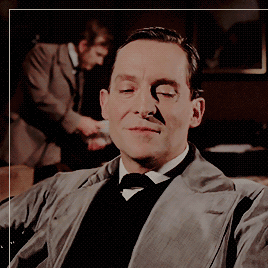
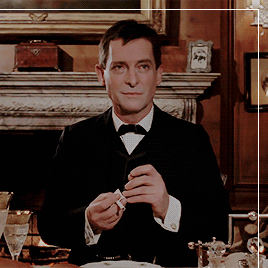
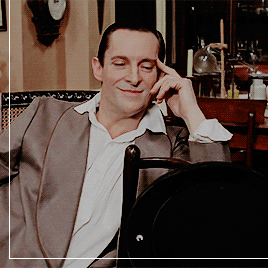
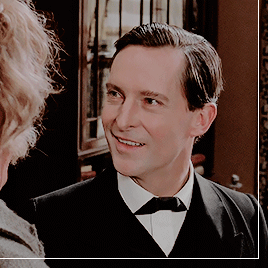
… A few yards off he stopped under a lamp-post and laughed in the hearty, noiseless fashion which was peculiar to him.—The Blue Carbuncle
2K notes
·
View notes
Photo

You must have a twinkle in your eye, a naughtiness – and the audience must realize your mind is working faster than your words.
2K notes
·
View notes
Text


"I'm gay, Watson".
570 notes
·
View notes
